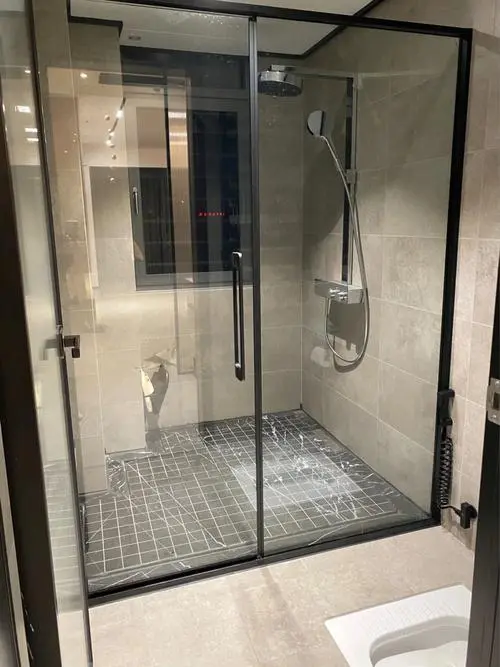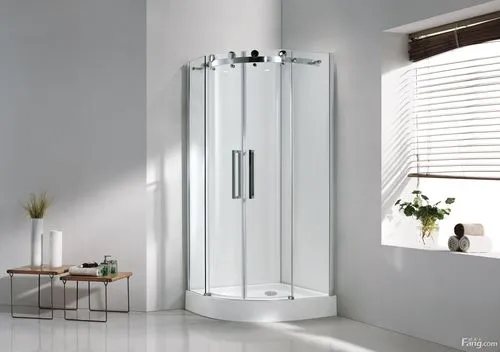In this comprehensive guide, we dive deep into everything you need to know about shower stalls. From their types and benefits, to installation, costs, maintenance, and even the hottest trends in shower stall designs, we’ve got it all covered. So, whether you’re planning a bathroom remodel or just curious about the world of shower enclosures, this article is sure to keep you engaged and informed. Let’s get started!


Shower stalls, or as they are interchangeably known, shower enclosures, are an integral part of modern bathrooms, contributing to both functionality and aesthetics. They come in a variety of designs and styles, each serving a specific need or preference.
The three main types of shower stalls include standalone stalls, bathtub-shower combos, and custom-built showers. Standalone stalls, which are popular for their compactness, consist of a single unit with a shower pan and surrounding walls. On the other hand, bathtub-shower combos are versatile solutions that provide both a tub and shower in a single unit.
Custom-built showers are tailored to specific design preferences and bathroom sizes. They can be built with a wide range of materials, such as tile, glass, or stone.
The choice of shower stall often depends on space availability, personal preferences, and budget. For example, shower stall kits are an affordable and easy-to-install option, while a luxurious walk-in shower stall could be the centerpiece of a high-end bathroom remodel.
When choosing a shower stall, the size is a critical factor to consider. Shower stalls come in various standard sizes, including 32×32 inches, 36×36 inches, 48×36 inches, and 60×36 inches for standalone enclosures. These dimensions represent the length and width of the shower pan, and they usually fit into most bathroom layouts.
The size of the bathroom and the space allocated for the shower will greatly influence your choice. A small bathroom might only accommodate a 32×32 inch stall, while a larger bathroom could fit a more spacious 48×36 inch enclosure.
However, custom-built showers provide flexibility in terms of dimensions. They can be designed to fit awkward or unique bathroom layouts.
For those looking for a specific size, Crown Shower provides a variety of dimensions, such as the 900 x 700 shower enclosure and the 1600 x 800 shower enclosure.
Shower stall material is a significant factor to consider, impacting the durability, maintenance requirements, and appearance of the shower. Common materials include acrylic, fiberglass, glass, tile, and solid surface materials.
Acrylic and fiberglass are popular due to their cost-effectiveness, easy installation, and low maintenance. However, they may lack the high-end look that other materials offer.
Glass shower enclosures offer a sleek, modern aesthetic and create a sense of spaciousness. However, they may require more cleaning to keep them looking their best.
Tile showers are versatile and customizable. With a variety of colors, textures, and patterns available, you can create a unique design that complements your bathroom decor. However, they require more maintenance than other materials and can be more expensive.
Solid surface materials, such as Corian or quartz, are durable and easy to clean. They can mimic the look of stone or tile without the maintenance.
When considering the material for your shower stall, consider factors like your budget, desired look, and maintenance willingness. Innovative options like the frameless quadrant shower enclosures from Crown Shower blend aesthetics and functionality in one.
Installing a shower stall involves several steps and can require a fair degree of DIY knowledge. Alternatively, hiring a professional may be a safer and more efficient option, especially for more complex installations.
First, you need to prepare the area where the shower stall will be installed. This involves removing any existing fixtures and ensuring the floor and walls are level.
Next, assemble the shower stall as per the manufacturer’s instructions. This usually involves connecting the base to the walls and then securing the assembly in place.
The plumbing needs to be connected next. This involves attaching the water supply lines to the shower head and faucet, and connecting the drain to the house’s plumbing.
Afterwards, apply caulk around the edges of the shower stall to create a watertight seal.
Finally, install any shower doors or curtains, and attach any remaining fixtures such as shower heads or faucets.
There are many detailed guides and resources available online to help you through the process. However, remember that installing a shower stall is a significant project that can impact the value and functionality of your home, so it’s important to ensure it’s done correctly.
Maintaining your shower stall is crucial for its longevity and performance. Basic maintenance includes regular cleaning to prevent the build-up of soap scum and mildew.
Depending on the material of your shower stall, certain cleaning products may be more effective or safe to use. For instance, a glass cleaner would be ideal for glass enclosures, while a tile cleaner would be suitable for tile showers.
In addition to cleaning, inspect your shower stall regularly for any signs of damage, such as cracks or leaks. Address these issues promptly to prevent them from escalating.
Silicone or caulk around the edges of the shower stall should also be inspected regularly. If it starts to peel or crack, re-caulking may be necessary to prevent water damage.
If your shower includes a door, ensure that the door’s seals are intact and that the door operates smoothly. Lubricating the door’s hinges can help maintain their functionality.
Moreover, installing a water softener can reduce mineral buildup on the shower surfaces, making them easier to clean.
The cost of a shower stall can vary greatly depending on factors like the type, size, material, and whether installation is included. A basic standalone shower stall kit can start around $200, while a high-end custom-built shower could cost several thousand dollars.
The cost of installation can also vary depending on the complexity of the job. A simple replacement of an existing shower stall might cost a few hundred dollars, while a full bathroom remodel involving plumbing relocation could cost several thousand.
It’s also worth considering the long-term costs, such as maintenance and potential repairs. For example, a cheap shower stall might end up costing more in the long run if it requires frequent repairs or replacements.
When calculating the cost, consider not just the initial price tag, but also the quality and durability of the product. A more expensive shower stall might be a better investment if it lasts longer and performs better.
Customizing a shower stall allows you to create a space that suits your specific needs and style. There are numerous ways to personalize a shower stall, from the choice of materials and fixtures to the layout and accessories.
Starting with the choice of materials, you can opt for a variety of options like tiles, glass, or solid surfaces. The choice of color, texture, and pattern can dramatically change the look of your shower. For instance, you can go for a classic look with white subway tiles or a sleek, modern aesthetic with frameless glass.
The choice of fixtures also plays a huge role in customizing your shower stall. You can choose from a variety of shower heads, faucets, and handles in different finishes, like chrome, brushed nickel, or bronze.
Shower stall kits are a popular option for those looking for a quick and affordable way to install a new shower. They come in a variety of styles, sizes, and materials, providing a comprehensive solution for your shower needs.
Shower stall kits typically include a shower pan, walls, and sometimes a door or curtain. Some kits also include fixtures like a shower head and faucet.
These kits are designed for easy assembly, making them a good choice for DIY enthusiasts. However, it’s still crucial to follow the manufacturer’s instructions carefully to ensure a watertight and safe installation.
There are also different types of shower stall kits, such as alcove shower kits, corner shower kits, and neo-angle shower kits. Each type has its benefits and drawbacks, so it’s important to choose one that suits your bathroom layout and personal preferences.
For example, corner and neo-angle shower kits are great for saving space in smaller bathrooms, while alcove shower kits can offer a larger showering area.
Yes, many shower stalls are designed to be accessible for people with disabilities. These accessible shower stalls often include features like barrier-free or low-threshold entrances, grab bars, built-in seats, and hand-held shower heads.
Barrier-free or low-threshold entrances allow for easy access into the shower, especially for those using a wheelchair or walker. Grab bars can provide stability and support while entering, showering, and exiting the shower.
Built-in seats can offer a comfortable and safe showering experience for those who have difficulty standing for extended periods. Hand-held shower heads allow for greater control and flexibility, making it easier to rinse off without needing to move around much.
Some manufacturers offer accessible shower stall kits that include these features, making it easier to upgrade your bathroom for accessibility.
If your shower stall is on the smaller side, there are several design tricks you can use to make it look bigger.
Firstly, using light colors for the walls of your shower can help create a sense of spaciousness. Light colors reflect more light, making the space feel brighter and larger.
Another strategy is to use clear glass for your shower enclosure instead of frosted or textured glass. Clear glass allows you to see through to the wall at the back of the shower, creating an illusion of depth.
Installing a large mirror on the wall opposite the shower can also make the bathroom feel larger. The mirror reflects light and the image of the shower, making the room appear double its actual size.
Lastly, maintaining a clean and clutter-free shower can also make it feel larger. Avoid overloading your shower with too many products or accessories.
The choice between a shower stall and a bathtub largely depends on personal preference, space availability, and lifestyle.
Shower stalls are generally more space-efficient, making them a good choice for smaller bathrooms. They’re also easier to get in and out of, which can be a significant advantage for older adults or those with mobility issues.
On the other hand, bathtubs can provide a luxurious and relaxing bathing experience. They’re also a must-have for families with young children, as bathing children in a shower can be challenging.
However, there’s also the option of a bathtub-shower combo, which offers the benefits of both. A combo can be a good solution if you have enough space and want the flexibility of both a quick shower and a relaxing bath.
Each option has its pros and cons, so consider your needs, preferences, and bathroom layout when making your choice.
This comprehensive guide has hopefully answered your most pressing questions about shower stalls. Whether you’re installing a new shower stall, upgrading an existing one, or simply learning more about your options, understanding these key points can help you make the best decisions for your bathroom. Remember, the right shower stall not only serves a functional purpose but also enhances the aesthetic appeal of your bathroom. So, choose wisely and enjoy a refreshing showering experience every time!
When it comes to bathroom renovations, one of the key elements to consider is the cost of a shower stall. Whether you’re remodeling your existing bathroom or building a new one, understanding the price range for shower stalls is essential. In this article, we will explore the factors that influence the cost of shower stalls and provide a breakdown of different types and their approximate prices.
The cost of a shower stall can vary depending on several factors, including:
Material: The material used for the shower stall can significantly impact the price. Common materials include fiberglass, acrylic, tile, and stone. Each material has its own price range, with tile and stone generally being more expensive than fiberglass or acrylic.
Size and Design: The size and design complexity of the shower stall can also affect the cost. Larger or custom-designed shower stalls may require more materials and labor, resulting in a higher price.
Installation: The cost of installation can vary depending on the complexity of the project and the labor rates in your area. Hiring a professional contractor for installation may incur additional costs but ensures a proper and efficient installation.
Additional Features: Additional features such as showerheads, faucets, glass doors, and built-in seating can add to the overall cost of the shower stall.
Let’s take a closer look at different types of shower stalls and their approximate prices:
Prefab shower stalls are pre-made and can be quickly installed. They are typically made from fiberglass or acrylic. The cost for these types of shower stalls can range anywhere from $700 to $3,000. Prefab stalls are a popular choice for those on a budget or looking for a quick installation.
A tiled walk-in shower offers a customizable and luxurious option. The cost of a tiled walk-in shower can vary depending on the materials and design. On average, these types of showers can cost between $2,100 and $17,500. The price range is influenced by factors such as the type of tile, size of the shower, and any additional features.
Shower-and-bathtub combinations provide the convenience of having both a shower and a bathtub in one unit. These installations usually cost around $2,000. This option is ideal for those who want the flexibility of both bathing options in their bathroom.
Shower liners are used to cover existing showers or tubs. They are usually made of plastic or acrylic and offer a cost-effective solution for updating the look of your bathroom. Shower liners can start at around $750, making them a budget-friendly option for those looking for a quick and affordable upgrade.
Please note that these prices are approximate and can vary depending on your location, the specific design, and the materials used. It’s essential to get quotes from local contractors to get a more accurate estimate for your specific needs.
The cost of a shower stall can vary greatly depending on the type, materials, and design. It’s important to consider your budget and preferences when choosing the right shower stall for your bathroom. By understanding the factors that influence the cost and exploring different options, you can make an informed decision that suits your needs and style.
Remember to consult with professionals and gather multiple quotes to ensure you get the best value for your investment. A well-designed and properly installed shower stall can enhance the functionality and aesthetics of your bathroom, providing you with a refreshing and enjoyable bathing experience for years to come.
Now, let’s summarize the information in a table:
| Shower Stall Type | Approximate Cost ($) |
|---|---|
| Prefab Shower Stalls | 700 – 3,000 |
| Tiled Walk-In Shower | 2,100 – 17,500 |
| Shower-and-Bathtub Combinations | 2,000 |
| Shower Liners | 750 |
And finally, here is a bar chart for the same data:
In conclusion, understanding the cost of a shower stall is crucial for planning your bathroom renovation. By considering factors such as material, size, design, and additional features, you can make an informed decision that fits your budget and preferences. Whether you opt for a prefab stall, a tiled walk-in shower, a shower-and-bathtub combination, or a shower liner, there are options available for every price range. Remember to consult with professionals and gather quotes to ensure you get the best value for your investment. Happy shower stall shopping!
